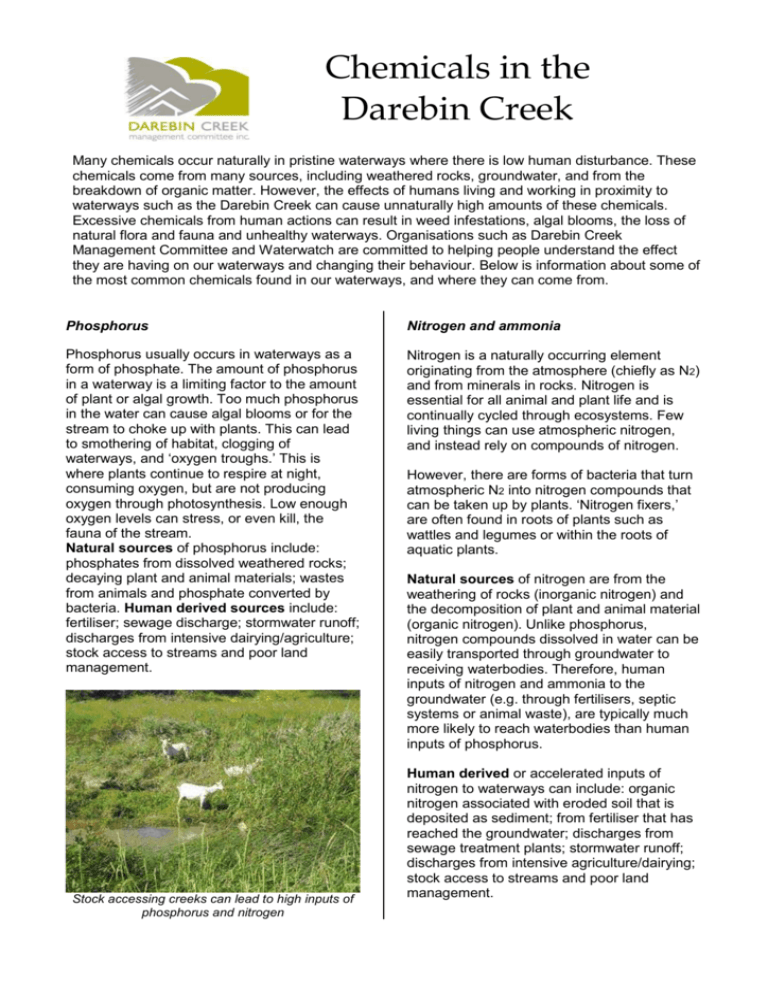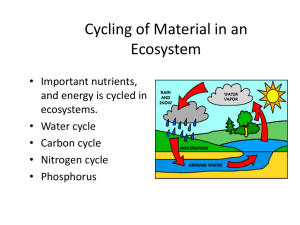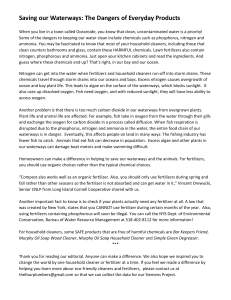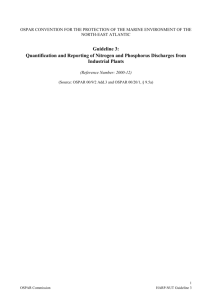Word - Darebin Creek Management Committee
advertisement

Chemicals in the Darebin Creek Many chemicals occur naturally in pristine waterways where there is low human disturbance. These chemicals come from many sources, including weathered rocks, groundwater, and from the breakdown of organic matter. However, the effects of humans living and working in proximity to waterways such as the Darebin Creek can cause unnaturally high amounts of these chemicals. Excessive chemicals from human actions can result in weed infestations, algal blooms, the loss of natural flora and fauna and unhealthy waterways. Organisations such as Darebin Creek Management Committee and Waterwatch are committed to helping people understand the effect they are having on our waterways and changing their behaviour. Below is information about some of the most common chemicals found in our waterways, and where they can come from. Phosphorus Nitrogen and ammonia Phosphorus usually occurs in waterways as a form of phosphate. The amount of phosphorus in a waterway is a limiting factor to the amount of plant or algal growth. Too much phosphorus in the water can cause algal blooms or for the stream to choke up with plants. This can lead to smothering of habitat, clogging of waterways, and ‘oxygen troughs.’ This is where plants continue to respire at night, consuming oxygen, but are not producing oxygen through photosynthesis. Low enough oxygen levels can stress, or even kill, the fauna of the stream. Natural sources of phosphorus include: phosphates from dissolved weathered rocks; decaying plant and animal materials; wastes from animals and phosphate converted by bacteria. Human derived sources include: fertiliser; sewage discharge; stormwater runoff; discharges from intensive dairying/agriculture; stock access to streams and poor land management. Nitrogen is a naturally occurring element originating from the atmosphere (chiefly as N2) and from minerals in rocks. Nitrogen is essential for all animal and plant life and is continually cycled through ecosystems. Few living things can use atmospheric nitrogen, and instead rely on compounds of nitrogen. Stock accessing creeks can lead to high inputs of phosphorus and nitrogen However, there are forms of bacteria that turn atmospheric N2 into nitrogen compounds that can be taken up by plants. ‘Nitrogen fixers,’ are often found in roots of plants such as wattles and legumes or within the roots of aquatic plants. Natural sources of nitrogen are from the weathering of rocks (inorganic nitrogen) and the decomposition of plant and animal material (organic nitrogen). Unlike phosphorus, nitrogen compounds dissolved in water can be easily transported through groundwater to receiving waterbodies. Therefore, human inputs of nitrogen and ammonia to the groundwater (e.g. through fertilisers, septic systems or animal waste), are typically much more likely to reach waterbodies than human inputs of phosphorus. Human derived or accelerated inputs of nitrogen to waterways can include: organic nitrogen associated with eroded soil that is deposited as sediment; from fertiliser that has reached the groundwater; discharges from sewage treatment plants; stormwater runoff; discharges from intensive agriculture/dairying; stock access to streams and poor land management. Dissolved oxygen All plants and animals living in water require oxygen – many of them in the form of dissolved oxygen. Oxygen is diffused from the atmosphere into the water. This diffusion is substantially increased by water turbulence such as waterfalls or riffles. Oxygen is also produced by plants, particularly algae, through photosynthesis. Algal build-up in the Darebin Creek Along with phosphorus, nitrogen can be a limiting nutrient for plant growth with low concentrations restricting plant growth and high concentrations contributing to excessive growths of algae and other plants. Therefore, similar to phosphorus, the monitoring and management of nitrogen is important in the protection of waterbodies. As the amount of organic matter increases the amount of oxygen used also increases. This is called oxygen demand. The major sources of oxygen demanding substances include: sewage effluent discharges; industrial discharges; septic tank discharges; leaf litter from the floodplain, river banks and dry waterways; instream plant material (macrophytes and algae); and blackwater events – low oxygen, organically rich waters entering a river from floodplain wetlands, backwaters and tributaries. Salinity Electrical conductivity (EC) measures the flow of electricity in a solution. Conductivity in a solution increases as the amount of salts dissolved in the water increases. The relationship between conductivity and dissolved salt concentrations is used as a measure of salinity. While some dissolved salts are needed for metabolic processes by aquatic organisms, excessive amounts may be toxic. Most freshwater aquatic organisms will not survive in high levels of salinity. Unfortunately, salinity levels in many places have been increasing substantially and have impacted on the condition of aquatic ecosystems. Salinity levels will vary due to the influences of geology, proximity to the coast, urban and agricultural runoff, sewage and industrial effluent and, most importantly, groundwater. Groundwater can have very high salt concentrations, and rising groundwater tables have elevated salinity levels in many waterways in Victoria. The Darebin Creek has high salinity levels, which are most likely the result of geology. Riffles in the creek help oxygenate the water Oxygen concentrations will vary over a 24hour (diurnal) cycle, even in pristine water bodies. Plant respiration at night will reduce oxygen levels over night while during the day, photosynthesis will produce oxygen and raise oxygen levels. In eutrophic conditions where there are blooms of algae or other aquatic plants, more plant cells are respiring (which consumes oxygen), creating very low oxygen concentrations overnight. In daylight hours such blooms can result in very high dissolved oxygen concentrations (called ‘supersaturation’). Acidity and alkalinity The pH of water is the measure of its acidity or alkalinity. It is measured by determining how many hydrogen ions are in the water. In water, some of the H2O molecules will dissociate into H+ ions (also called protons) and OH- ions (hydroxide). When there are more H+ ions than OH- ions, the water will have a pH below 7 and is said to be ‘acidic’. When there are more OH- ions than H+ ions, the water will have a pH greater than 7 and is said to be ‘alkaline’. The pH scale is logarithmic, which means that a change of two units (e.g. from 7 to 5) is ten times the change of one unit (e.g. from 7 to 6). In other words, lowering pH from 7 to 6 represents a ten-fold increase in H+ ions, whereas a reduction from 7 to 5 represents a hundred-fold increase, and a reduction from 7 to 4 represents a thousand-fold increase. As a consequence, the further the pH is from neutral (7), the greater the impact of any further movement from 7. water level drops due to drought or drainage, the sediments become exposed to oxygen and sulphuric acid is formed. When the sediment is re-wetted, acid can be mobilised from the sediments. Discharges from factories, mine sites and other industrial locations can often contain liquids with high or low pH. Emissions from car exhausts and coal-burning power plants increase the concentrations of nitrogen oxides (NO2, NO3) and sulphur dioxide (SO2) in the air. These pollutants can react in the atmosphere to form nitric acid (HNO3) and sulphuric acid (H2SO4). These acids can affect the pH of streams by combining with moisture in the air and falling to the earth as acid rain. The pH of a water body can have serious direct and indirect impacts on the organisms living within the water and on the potential uses of the water. Changes to pH may directly affect the physiological functioning of aquatic biota, including enzyme functioning and membrane processes. Low pH has been reported to have adverse effects on fish and aquatic macroinvertebrates, including physiological functioning, spawning failure and diminished egg hatching. The pH of a water body is naturally influenced by geology, soils, salinity, algal and other plant photosynthesis and respiration, and rainfall. The geology of the catchment can influence pH through the bedrock. For example, granitic rocks typically contribute to a lowering of groundwater pH, whereas basaltic rocks and rocks with carbonates tend to increase pH. Human-induced changes to pH in water bodies can include agricultural land practices (leading to soil acidification), waste discharges, and air pollution. Soil acidification typically occurs through leaching from the upper soil horizons, leaving an excess of H+ ions. Water flowing through the acidic soils enters the receiving water body with low pH. Agricultural practices can also lead to increased nutrients, which increases algal growth and consequently leads to the greater diurnal fluctuation of pH as described previously. Changes to the hydrology of rivers and wetlands can also lead to acidification. If the An industrial pollution spill in the Darebin Creek Most natural freshwaters within Victoria have a pH in the range 6.5 to 8.0. The more saline areas in western and north-western Victoria generally have higher pH. Waterwatch monitoring If you are interested in being trained to become a volunteer Waterwatch monitor, you can contact DCMC on 9499 4454. Further Reading Data Interpretation Manual, Waterwatch. http://www.vic.waterwatch.org.au/monitoring&-data/1011/









